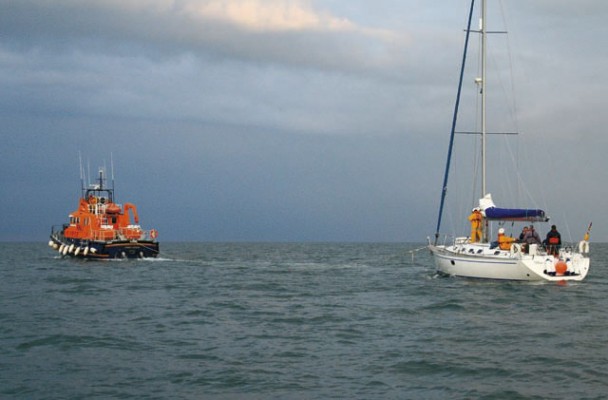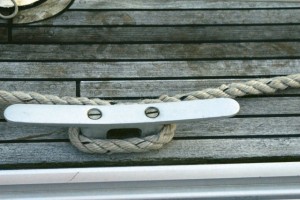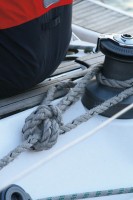If you've had to call out the lifeboat for a tow, it helps to be prepared. David Harding explains how to prepare your boat for a safe tow at sea
Imagine that the lifeboat is on the way to take you in tow. Do you sit and wait, in the knowledge that the lifeboat’s crew will assess the situation and tell you exactly what to do, or is there anything you can do to prepare?
The RNLI – and other lifeboat crews – will of course know the best way to rig up a tow depending on the boat, the weather conditions, the sea state and where you’re going. Nonetheless, if you’re ready when they get there you will save potentially vital time.
If your idea of being ready is securing a line to a bow cleat and having it neatly coiled on the foredeck you will be wasting time not saving it, because a bow cleat is no place to secure a line unless you’re being towed at slow speed in flat water. Taking it round the mast might be better, but only if the mast is keel-stepped. There is a better solution. Here is how to prepare for a lifeboat tow.
A bridle is best
To minimise snatching and point-loading with a towing line, you need to take it around several strong-points over the whole length of the boat. The ideal is to rig up a bridle down each side using plaited mooring lines (plaited is best because it stretches much more than braided lines). Start at the bow with a long line, at least twice the length of the boat. Divide it in two and make a loop in the middle with a bowline. This is where you’re going to attach the line from the lifeboat. Leaving enough length for the loop to be several feet forward of the bow, lead one end down one side, taking a turn around any suitable cleat on the way – probably a bow cleat and, if you have one, a midships spring cleat. Just take one complete 360° turn around the cleats, nothing more. Then secure the tail around one of the primary winches before doing the same with the other half of the line down the opposite side of the boat.
If you don’t have one line that’s long enough to act as both sides of the bridle, use two separate lines and join them at the bow.
A bridle like this ensures that the load is taken evenly over half-a-dozen strong points – possibly more if you have extra cleats or winches. If you don’t have spring cleats, using just the bow cleats and primary winches will still help spread the load.
Because the line is looped around the cleats the weight should be evened out, so none of them is taking an unfair portion. Just as significantly, the length of the bridle allows the line to stretch, helping to keep snatch-loads to a minimum.
If you have a bridle rigged up and ready for when the lifeboat arrives you can take their line, make it fast to the loop at the bow, and off you go. The same technique applies if you’re being towed by another vessel, though you might not receive such competent instruction and assistance. If you’re towing someone else, rig up your towing line on a bridle running the other way – from stern to bow. A lifeboat will have a massive towing point near the stern, but on a yacht you will need to distribute the loads down each side in the same way as if you’re being towed.
How to rig a bridle
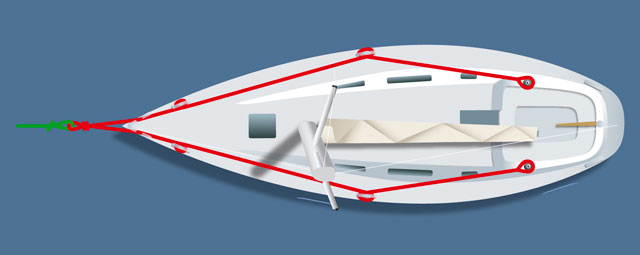
The bridle (red) is secured on the yacht’s primary winches and led forward with 360 degree turns around bow and midships cleats. A loop in the end needs to be on the centreline
Practice and problems
To see how it should be done, I observed a training exercise in which the Torbay Lifeboat took in tow a Gib’Sea 43 run by Plain Sailing, a sea school in Brixham.
Kevin Ashworth, a director of Plain Sailing and member of the Torbay Lifeboat crew, explains some of the many issues they have to consider.
‘We will make radio contact before we get there and ask the yacht’s crew to rig up a bridle, but often they don’t get it right. We get a pretty good idea of the crew’s ability over the radio so we know how much help they’re likely to need rigging up the tow. If conditions allow we will always put at least one person across on to the yacht; two if it’s clear that more help is needed.’
Plain Sailing’s principal, George Turpin, stresses the importance of looking out for chafe points, as a tow might be 15-20 miles or more. Another important point to check is that the yacht’s crew hasn’t led the bridle under the pin in the anchor roller: it will soon break free.
Pulpit design can determine the best way to lead the bridle forward and off the boat. A low pulpit can easily be wrenched off by a line that passes underneath it if the yacht is pitching in heavy seas. Sometimes it’s necessary to rig up a strop over the bridle at the stem to prevent damage to the pulpit.
Even if the yacht’s crew has rigged up the bridle properly, they will often receive the throwing line from the lifeboat and secure that to the bridle. As Kevin says, ‘We need to tell them that’s the throwing line, not what we’re towing you with: keep pulling!’
The towing line itself is typically around 25mm in diameter; that’s why you need a good loop in the bridle well forward of the stem to which you can attach it.
1. Getting ready for the tow

The lifeboat will come along the yacht’s windward side to transfer a crewmember or two (and take a line to the yacht)
When the lifeboat has transferred a crew-member or two on to the yacht, it’s time to establish priorities. ‘We get on board, assess the situation, check any casualties and get everything under control, then decide what we’re trying to achieve and how to do it safely,’ explains Kevin Ashworth.

The towing line is secured to the loop in the bridle and the lifeboat pulls ahead gently to take the weight
If the yacht is still sailing they will normally heave to, drop the mainsail and roll away the genoa. They will also check the bridle and make any adjustments, re-rigging it using lines from the lifeboat if the yacht’s own lines are inadequate. As this was a training exercise for the RNLI, several crewmembers were put aboard the Gib’Sea: normally you would only get a couple at most!
2. Time for a drogue
It might seem strange to want to increase the resistance of the yacht being towed, but at times it can be vital – if, for example, the tow is downwind in steep seas over a bar such as at the entrance to Salcombe. It would be unfortunate if the yacht got picked up by a wave and came surfing past, or into, the lifeboat.
The drogue is rigged up on a bridle over the stern, with each end of the bridle’s line led through a fairlead and made fast to a winch.
3. Towing alongside

The alongside tow under way. Most of the time the bow and stern lines will be taking little or no weight
Once you get into flat water on the approach to port, the lifeboat will tow you from alongside for better manoeuvrability. The coxswain will slow down and the lifeboat crew will take the towing line off the lifeboat’s stern and move it to the bow, leaving it attached to the yacht’s bridle, so it becomes the bow breast-line for the alongside tow. Then, once the two boats are alongside each other, they will rig up a stern breast-line and springs running both ways in the same pattern you would use when mooring alongside a pontoon or another boat.
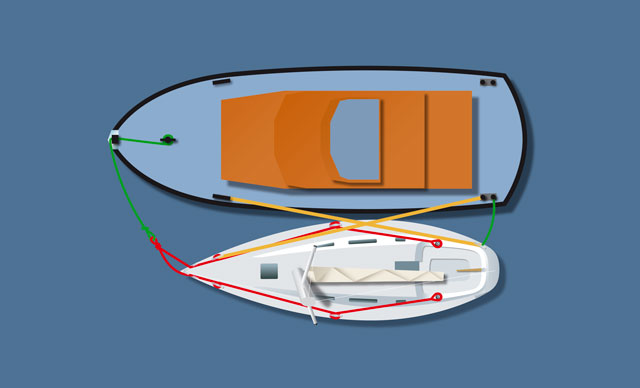
Just like mooring alongside a pontoon, a bow line (green, in this case the tow line, still attached to the bridle), breast line (green) and fore-and aft-springs (yellow) are used for the alongside tow
The coxswain will nudge the lifeboat ahead and astern as the springs are rigged up to make sure they’re both tight: it’s the springs that do most of the work, with the breast-lines just keeping the bow and stern in check.




